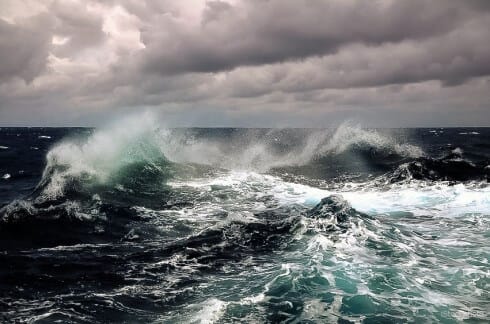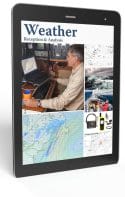
Many times over the years people have said things to me like:
He lost his boat because the weather router screwed up.
We got a real dusting and did a lot of damage because the weather forecast was wrong.
This might sound perfectly logical, but it’s not.
For example, some time ago a weather router sent a boat into a piece of ocean with a substantial current in an attempt to avoid bad weather.
The weather deteriorated more than expected and the resulting wind-against-current generated breaking waves that rolled the boat and eventually led to her abandonment.
Many people blamed the router and the forecast. That’s simply wrong. The skipper was at fault.
Taking Responsibility
Why? Because before going offshore a skipper should understand the conditions and risks prevalent in the sea area to be crossed as well as their boat’s capabilities so that he or she can properly decide when to put to sea and how to route the passage.
A weather router or automated forecast and/or routing tool is an adviser only, not a substitute for a well-informed skipper.
It is the skipper’s responsibility to act in a safe manner, which, going back to the example above, would not normally include entering a high-current area with heavy weather coming.
Over the years, I have had weather routers advise me to:
- leave port as I stood in a telephone booth rocked by 60-knot gusts;
- sail into an area of 5/10 pack ice to get a more favourable wind direction;
- leave on a crossing with a hurricane tracking up the coast just 400 miles away.
Needless to say, I did none of those things. And, if I had taken their advice and something had gone wrong, it would have been my responsibility alone, not theirs.
Weather routers can bring meteorological understanding to a situation that no amateur can hope to match, but most of them are not mariners and they are not the skipper of our boat.
Automated Tools
The same applies to cool automated tools like PredictWind and others, several that include automated routing. While they are fantastically useful, they are also far from infallible, so we need to have enough knowledge to look at the output of these tools with a critical eye and understand their many limitations, and then make good decisions.
Once again, we are the skippers of our boats, not some automated weather tool.
This Online Book
So how should we go about getting weather information and using it to make the right decisions when offshore, even if we blend it with advice from a weather router?
To answer that question, this book shares our system on Morgan’s Cloud, developed over some three decades of offshore cruising, to route planning, weather reception, and risk analysis.
This is not some esoteric weather text that will take days to read and be impossible to understand; rather, think of it as an organized set of practical tips and procedures that will, together with a reasonable amount of practice, make your cruising safer and more comfortable.
Yes, It Works
To accomplish that goal we take a strategic as well as tactical approach to making our weather-related cruising decisions. Let’s take a look at an example:
Taking a Break

A few years ago, and while we were writing the first version of this Online Book, we were cruising the remote Quebec Lower North Shore of the Gulf of St. Lawrence, and the weather was unsettled, so we picked a nice sheltered anchorage with good hiking possibilities and snugged in for several days of catching up on boat work, writing, and taking a break from being on the move.
Then Maximizing Fun
But even before we snugged down, I could see that settled weather would return the next week, so we planned to visit a couple of isolated communities with less-than-snug harbours, and then use the tail end of that pattern, with the associated generally northerly winds—the opposite of the prevailing southerlies (we don’t say “down north” in this part of the world for nothing)—to passage south.
And that’s exactly how it worked out. And this is just one example.
Ocean Passages, Too
And this same kind of strategic weather management can be used to plan an ocean passage to minimize nasty weather.
Let’s Do It
Read on for how to make more comfortable and safer cruises happen.


I agree with you regarding the responsibility of the skipper. As a one time forecaster and with some experience of weather routing, I have to doubt the value of routing guidance whilst on passage. Obviously, a long distance sailor will choose the best time of year and best climatological route for an ocean passage. It might be reassuring to take professional advice on that.
Once clear of land, having started with a reasonable weather window, it is my belief that a typical cruising yacht will be too slow, weather systems too large, and forecasting not sufficiently precise to make any significant course changes. If a major storm has your name on it, then it will be almost impossible to avoid. The best use of forecasts will be to get warnings of bad weather and to prepare accordingly. With synoptic charts and, maybe, with GRIBs, the person in the best position to make decisions will be the skipper.
A good example was last year when a friend of mine sailed from Bermuda to the Azores. He made his own decisions informed largely by GRIBs. Two other yachts were using Herb. Despite Herb’s experience, my friend says that he got to Bermuda about two weeks earlier. No doubt Herb had a bad day but the other two boats went a long way north then a long way south of my friend. They got on the wrong side of a depression.
I can give a similar, but opposite anecdote of a similar voyage. Myself and a similar sized boat sailed by some friends departed North Carolina, I chose to use Herb for routing information and my friends who did not have SSB on board obviously did not. We arrived in the Azores 10 days before them having been routed to towards lighter weather than preferable. However we did not arrive with broken teeth having been caught in continuos gales at 42 north. The point is of course that information is key and early decisions to route one way or another can have significant impact upon comfort and safety. Whilst I can take little credit for that particular success access to information enabled a view of the macro synoptic picture.
A decade later and an updated comment, cool!!
The blame game. This culture is riddled with that. The quickest way to learn… really learn, is to take responsibility for everything that happens to you. Great article and I will be reading the rest of it for sure.
s/v Valinor
Sabre 34 Mark I